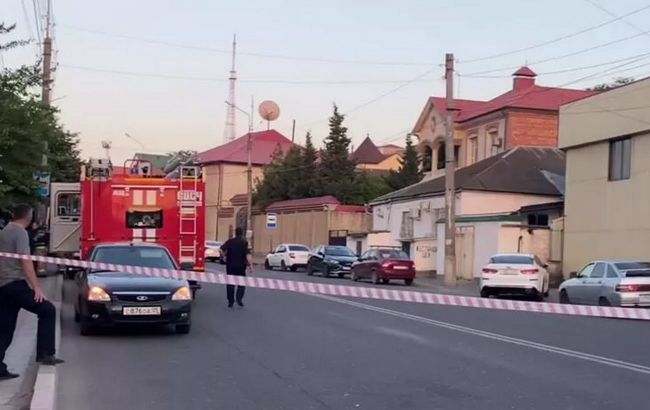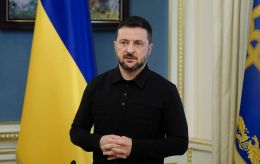Church attacks leave 20 dead in Dagestan: What happened and who's responsible
 Photo: one of the sites of terrorist attacks in Dagestan (Russian media)
Photo: one of the sites of terrorist attacks in Dagestan (Russian media)
The day before, a series of attacks on Orthodox churches and synagogues took place in the Republic of Dagestan (Russian Federation). According to preliminary data, 19 people were killed as a result of the attacks and shootouts with security forces.
More details about what happened in the cities of Derbent and Makhachkala and who might be behind the attacks are in the RBC-Ukraine report.
Contents
- What happened in Derbent and Makhachkala
- What is known about the victims
- What is known about the attackers
- Who might be behind the attack
What happened in Derbent and Makhachkala
Reports of shootings in the two largest cities of Dagestan appeared around 18:00. Unknown assailants attacked the Church of the Intercession of the Holy Virgin in Derbent, resulting in the death of the priest. Shortly after, it was reported that the Kele-Numaz synagogue, located approximately 500 meters from the Orthodox church, was also attacked.
According to the Russian Ministry of Internal Affairs, the attackers fired at the buildings with automatic weapons. A severe fire broke out in the synagogue, which was fought until night.
It should be noted that the attacks occurred on the Orthodox holiday of Trinity Sunday. Regarding the synagogue, the Russian Jewish Congress stated that the attack in Derbent took place shortly before the evening prayer. Police officers and security guards took the main impact, and the building was set on fire using Molotov cocktails.
During this time, a shooting was reported in Makhachkala. Several individuals with automatic weapons fired at a traffic police post near the local synagogue. Another shootout occurred near the Holy Assumption Cathedral.
Initial reports of hostage-taking in the church were not confirmed. Eighteen people barricaded themselves inside and were safely evacuated at night. During the shootout with the security forces, the attackers were in a neighboring building.
Additionally, there was a shooting in the village of Sergokala, the administrative center of the Sergokala district, located between Derbent and Makhachkala. Unknown assailants fired at a police car.
Russian security forces imposed a counter-terrorism operation regime. Armored vehicles appeared on the streets of Derbent, and the exits from the city were blocked. The National Guard stormed a residential building where the militants were holed up. By late evening, the exits from Makhachkala were also blocked, and shootouts continued. On the morning of June 24, the counter-terrorism operation regime was lifted due to the "elimination of threats to the life and health of citizens."
Preliminary data indicate that 15 law enforcement officers and four civilians were killed. Security forces neutralized five attackers, whose identities have been established. The attacks are being investigated as a terrorist act.
Telegram channels report different figures. According to the "112" and Baza channels, 20 people were killed in Derbent and Makhachkala, and another 44 were injured, including 37 security personnel. These figures have not been officially confirmed, with authorities reporting 25 injured.
What is known about the victims
According to the Dagestan Ministry of Internal Affairs, among the deceased is Mavludin Khidirnabiyev, head of the Dagestanskie Ogni police department, who sustained severe injuries in the shootout. Another victim was the security guard of the church in Makhachkala, armed only with a gas pistol, as noted by Dagestan Public Monitoring Commission Chairman Shamil Khadulaev.
During the attack on the church in Derbent, 66-year-old priest Father Nikolai Kotelnikov, who had served in the church for over 40 years, was killed.
According to his daughter, the attackers broke into the church, set the main icon on fire, and opened indiscriminate fire. They then entered Father Kotelnikov's house, shot him in the head in front of his wife, and set the house on fire.

Photo: Nikolai Kotelnikov, priest of the Orthodox church in Derbent,
could have been the main target of the militants (patriarchia.ru)
Father Nikolai Kotelnikov was well-known in Derbent. Russian media reports that he was the prototype of the Orthodox priest on the monument "Brotherhood of Three Religions" in the city center. In addition to the figure of the priest, the monument features figures of a rabbi and a mullah. Besides Dagestani Muslims and Orthodox Russians, many Mountain Jews also live in Derbent.
Kotelnikov was credited with bringing a piece of the so-called Holy Fire, which holds significant importance for Christians, to the city every Easter since 2005.
Today, a screenshot purportedly from a militants' chat surfaced online. According to it, Kotelnikov might have been the primary target, as his photo was pinned in the chat. The authenticity of the screenshot has not been confirmed, and the correspondence was in the Avar language. This language is widely spoken among the Dargins, one of the ethnic groups in Dagestan. It has been revealed that the attackers were Dargins.
What is known about the attackers
Two of the neutralized militants were identified as the sons of Magomed Omarov, the 64-year-old secretary of the Dagestan branch of United Russia and head of the Sergokala district. Their names are Adil and Osman.
Osman Omarov was 31 years old. In 2012, he worked at the Derbent Brandy Factory, then at the local branch of Sberbank. In 2017, he became an entrepreneur, raising cattle, engaging in the construction business, owning the Lemonade cafe, and allegedly having connections with Turkey.
Adil Omarov was 37 years old. He graduated from the law faculty of Dagestan State University and practiced freestyle wrestling. According to the Verstka, he also worked in a company that installed and serviced water supply systems.

Photo: Magomed Omarov, head of the Sergokalinsky district, said that his sons were supporters of Wahhabism (rosmedia)
The third neutralized militant was Abdusamad Amadziyev, Omarov's nephew. At the time of the attack, he was 32 years old and was known to have previously worked for a local gas distribution company.
During interrogation, the detained head of the Sergokala district stated that he had known for several years that his children and nephew were Wahhabis—adherents of a radical branch of Islam. Wahhabism focuses on purifying Islam from the influences of other religious beliefs and cultural, ethnic, and other characteristics of various Muslim peoples.
According to Omarov, Osman was the most radical, while the rest of the family did not support them. In recent years, the father has not communicated with his two sons and has told the security forces that he does not consider himself part of this movement.
According to preliminary data, 28-year-old Gadzimurad Kagiyev was another neutralized militant in Derbent. He was a master of sports in freestyle wrestling, a graduate of Abdulmanap Nurmagomedov's school, and a fighter for his son Khabib's club, Eagles MMA. During his MMA career, he had two fights.
The fifth killed militant, Ali Zakarygayev, participated in the elections for deputies of the Sergokala district and was the head of the local branch of A Just Russia. Today, he was posthumously expelled from the party.
Who might be behind the attack
According to one version, the attackers are also supporters of an international Islamist terrorist organization, judging by their actions, shouts, and appearance. The attack was prepared for about a month, was carefully planned, and Orthodox churches were deliberately chosen as targets on Trinity Sunday.
Additionally, according to Verstka, the Dagestan branch of the Investigative Committee is considering the version that the militants were part of a so-called sleeper terrorist cell.

Photo: one of the sites of terrorist attacks in Dagestan (Russian media)
As expected, the attacks have been linked to the Russian-Ukrainian war. According to the head of Dagestan, Sergey Melikov, the authorities allegedly understand who is behind the organization of these attacks. He stated that "the war is coming to our home. Senator Dmitry Rogozin's comment (representing the occupied part of the Zaporizhzhia region) was particularly resonant, as he called not to link the shooting in the North Caucasus with Ukraine and the West. Vladimir Putin does not plan to make a special address.
According to analysts at the Institute for the Study of War (ISW), the coordinated attack was likely carried out by the North Caucasus branch of ISIS, known as Vilayat Kavkaz.
They emphasize that on June 23, the Russian branch of Al-Azaim Media (a resource of the Vilayat Khorasan organization) published a statement congratulating the "brothers from the Caucasus" for demonstrating their capabilities.
Although Al-Azaim did not take responsibility for the attack, the mention of the Caucasus convincingly suggests a possible involvement of Vilayat Kavkaz, according to ISW. They also remind that earlier, the anti-terrorist structure of the Shanghai Cooperation Organization (SCO) warned about the activation of Vilayat Kavkaz and increased recruitment of militants after the March 22 terrorist attacks in Crocus City Hall.
The report notes that since March 2024, Russian authorities have been trying to conduct a counter-terrorism operation in the North Caucasus to counter the growing influence of radical Islamists. However, after the terrorist attack in Crocus, the reaction mostly focused on baseless accusations against Ukraine and the West.
"Russia's increasingly tense relationship with its Muslim minority population, especially in the Caucasus, will likely continue to provide Vilayat Kavkaz and other extremist groups with a valuable recruitment base," ISW added.
Sources: materials from Russian media, Telegram channels, information from the Investigative Committee of the Russian Federation, statements by the head of Dagestan Sergey Melikov, and the report of the Institute for the Study of War (ISW).

